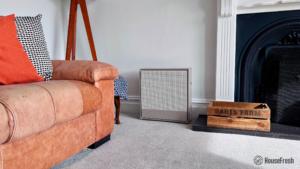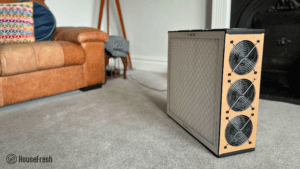The term ‘VOC’ stands for volatile organic compounds, which are gases that can contain various chemicals, some of which will be harmful to your health.
Many VOCs are human-made chemicals used and produced in the manufacture of pharmaceuticals, paints and refrigerants. But VOCs can also be created through chlorination in water treatments and contained in industrial solvents, pesticides, building materials and fuel.
These gases can enter your home through common household products you use daily, such as paints, cleaning products, and even beauty products like perfumes and nail polish, among many others. They can also enter your place of work through equipment like printers and photocopiers.
According to the U.S. Environmental Protection Agency, VOC concentrations can be up to ten times higher indoors than outdoors. Outside, VOCs usually dissipate without causing harm. But indoors, these chemicals can linger and cause adverse health effects ranging from headaches and throat irritation to kidney and liver damage.
If you don’t want to read my full article, have a look at the table below with my recommendations for the best air purifiers to deal with VOCs based on data from nearly 100 tests:
| BEST OVERALL | HEAVY VOCs OPTION | BUDGET OPTION | SMART OPTION | LARGE ROOM OPTION | |
|---|---|---|---|---|---|
| IQAir HealthPro Plus | Austin HealthMate | Winix 5500-2 | Levoit Core 400S | Smart Air Blast Mini | |
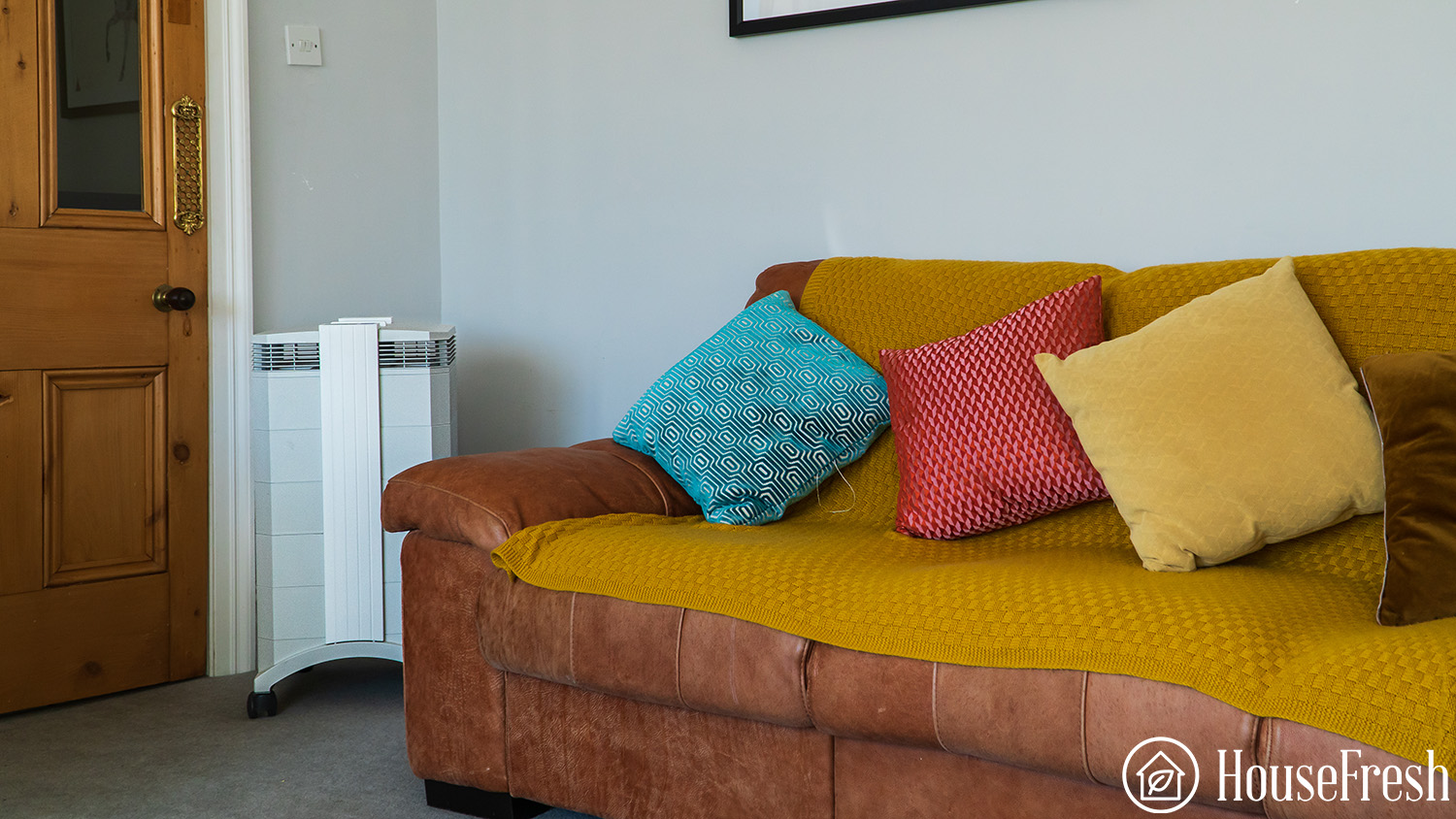 |  |  |  |  | |
| Time to PM1 zero | 28 minutes | 52 minutes | 23 minutes | 24 minutes | 15 minutes |
| HouseFresh CADR | 213 cfm | 156 cfm | 260 cfm | 213 cfm | 400 cfm |
| Filter tech | Hyper HEPA + V5-Cell carbon | HEPA + carbon | True HEPA + carbon + ionizer | Bonded particle + carbon | H13 HEPA + carbon |
| Activated carbon amount | 5 lbs | 15 lbs | 0.5 lbs | 0.99 lbs | 1.56 lbs |
| Max room size | 319 sq. ft. | 234 sq. ft. | 390 sq. ft. | 319 sq. ft. | 600 sq. ft. |
| Yearly running costs | $421.47 | $283.03 | $161.53 | $157.94 | $285.29 |
| List price | $1,199.99 | $765.00 | $262.44 | $182.99 | Price not available |
If you are dealing with serious VOCs, try to ventilate your house as much as possible by opening windows and doors.
This is especially important when using VOC-heavy chemicals like paint stripping or cleaning products. Always perform this type of activity with your windows open to let more air move inside your home.
It’s important to clarify that many of the most popular air purifiers you will find online or at your local appliance shop are designed to tackle other types of pollutants, such as pollen, dust or cigarette smoke. These devices may have excellent particle filters (such as medical-grade H13 HEPA), but you need to look for gas filters with large amounts of activated carbon.
With those disclaimers out of the way, let me tell you about the air purifiers we recommend to tackle VOCs indoors.
1. Best for most people: IQAir HealthPro Plus (5.5 lbs carbon)
With a high-quality HyperHEPA filter and packed with 5 lbs of activated carbon and zeolite, the HealthPro Plus is our top pick for dealing with VOCs.

The HealthPro Plus from IQAir looks like a device from the 90s because it is: it was first released in 1998, and all those decades later, it is still one of the most recommended air purifiers in the world. This is a result of excellent build quality, a trustworthy brand, a very powerful fan, a unique HyperHEPA filter to capture the smallest of particles and an impressive gas filter for VOCs with 5 lbs of activated carbon and zeolite.
If you are looking for an air purifier that can clear the air from not only chemical gases and smells but also dust, smoke, pollen and allergens, then you should consider getting an IQAir HealthPro Plus.
What we really like
What we think could be better
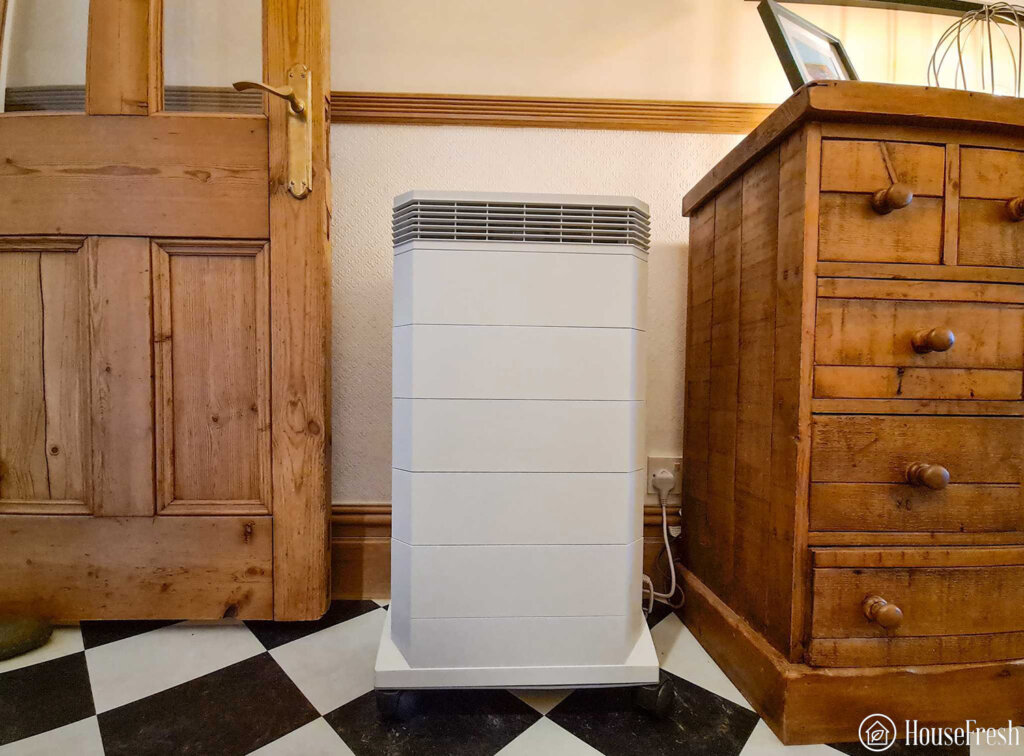
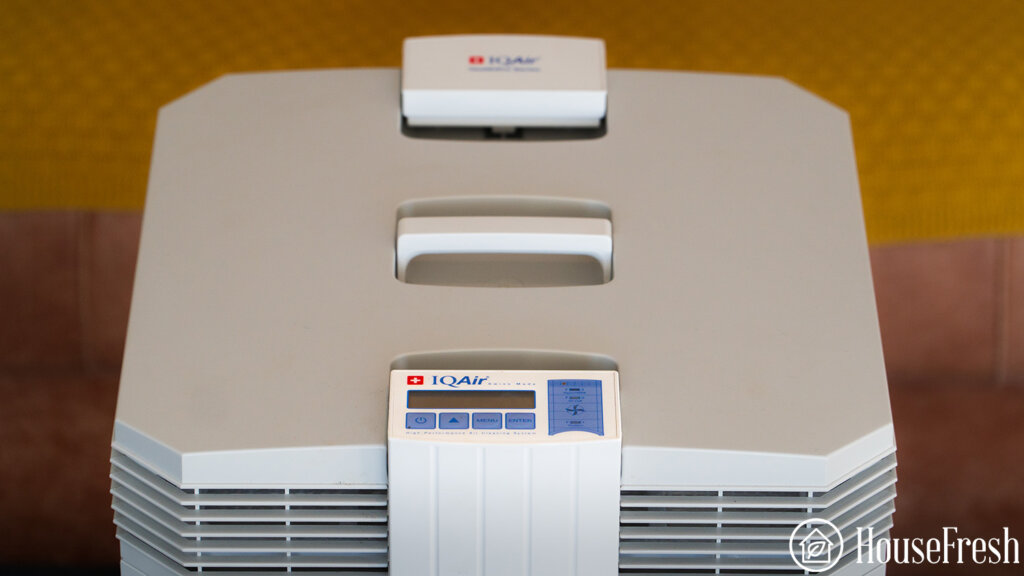
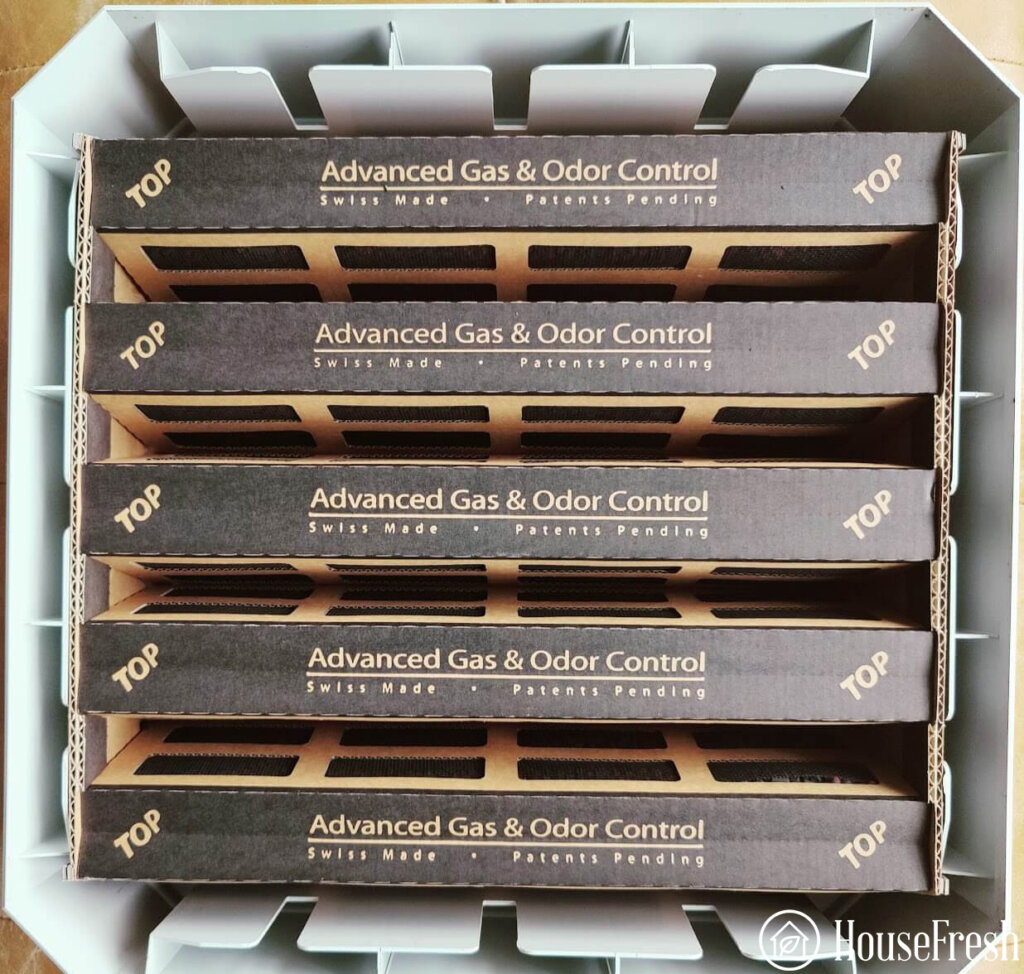
| HouseFresh rating: | ★★★★★ |
| Time to clean our 728 cubic feet test room (with the device running at top speed): | 28 minutes |
| Air purifier technology: | HyperHEPA and V50-CELL gas and odor filter |
| Recommended room size (5 air changes per hour): | 375 sq. ft. |
| Clean air delivery rate (CADR): | Estimated: 250 CFM |
| Dimensions (in inches / in cm): | 28H x 18W x 16D inches (71H x 38W x 41D cm) |
| Weight (in pounds / in kg): | 35 lbs (15.88 kg) |
| Filter life: | 4 years |
| Noise level (measured from 3 ft. away): | Speed 1: 36.9 dB Speed 2: 37.2 dB Speed 3: 40.9 dB Speed 4: 47.2 dB Speed 5: 53.9 dB Speed 6: 61.2 dB |
| Electricity consumption in watts (recorded with an electricity usage monitor): | Standby mode: 1 watts Speed 1: 16.5 watts Speed 2: 32.7 watts Speed 3: 47.3 watts Speed 4: 69 watts Speed 5: 94.3 watts Speed 6: 145.2 watts |
| Estimated running costs (electricity consumption + filter replacements): | $421.47 per year |
| Cost per CADR cfm (based on dust CFM as reported by AHAM): | $3.60 |
| Manufacturer’s warranty: | 10 years |
| Country of manufacture: | Switzerland / Germany |
2. Best for serious VOCs: Austin HealthMate (with 15 lbs carbon)
This air purifier boasts the highest amount of activated carbon (15 lbs) of any device currently on the market.
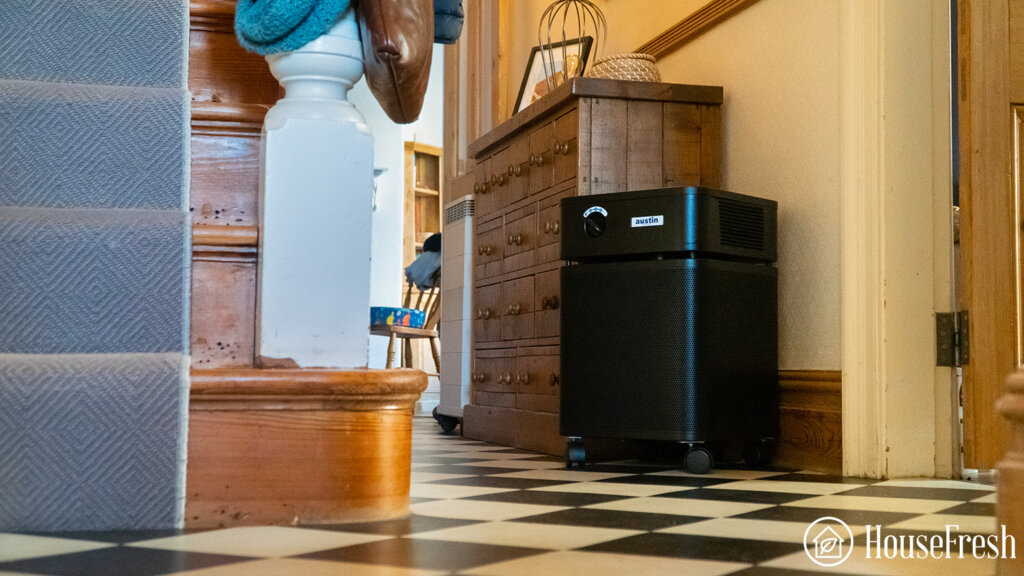
Austin Air has been manufacturing air purifiers from its factory in Buffalo, New York, since 1990. The HealthMate is Austin Air’s most popular device, and it has been designed to effectively remove VOCs and chemicals from the air thanks to a MASSIVE carbon filter packed with 15 lbs of activated carbon and zeolite.
You need to know that this large quantity of carbon will restrict airflow, impacting the HealthMate’s HEPA filter’s ability to quickly remove particles from the air. In our particle removal test, the HealthMate needed 52 minutes to reach PM1 zero — this is 24 minutes slower than what we saw with the IQAir HealthPro Plus at the top of this list. That said, if you’re looking for the best device to remove chemical gases and unwanted odors from the air, then Austin Air HealthMate is the best option for you.
What we really like
What we think could be better
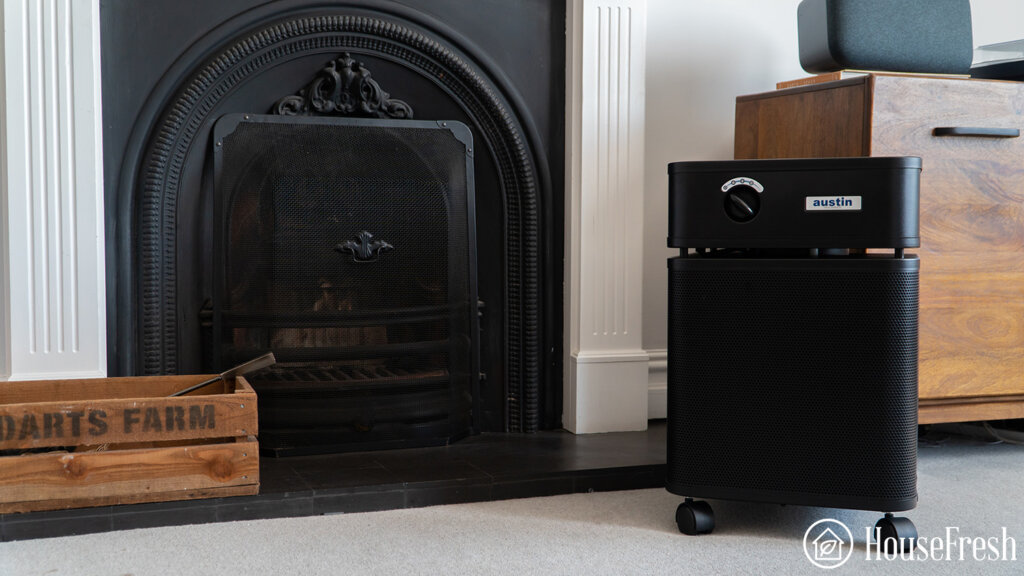
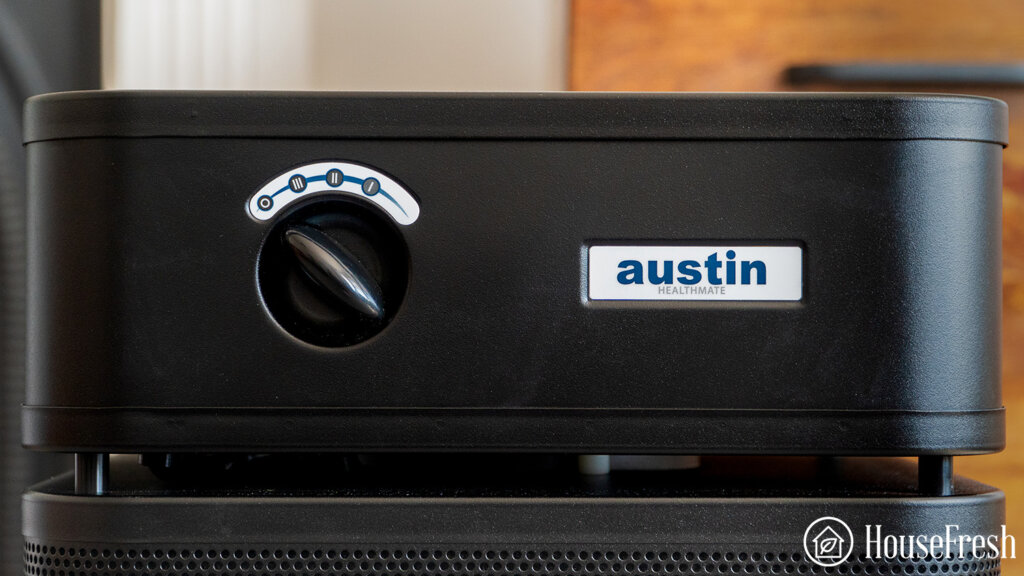

| HouseFresh rating: | ★★★★☆ |
| Time to clean our 728 cubic feet test room (with the device running at top speed): | 52 minutes |
| Air purifier technology: | HEPA filter and 15 lb of activated carbon |
| Recommended room size (estimated by HouseFresh to achieve 5 air changes per hour): | 234 sq. ft. |
| Clean air delivery rate (CADR): | Estimated: 156 CFM |
| Dimensions (in inches / in cm): | 23H x 14.5W x 14.5D inches (58.4H x 36.8W x 36.8D cm) |
| Weight (in pounds / in kg): | 20.41 lbs (9.26 kg) |
| Filter life: | 5 years |
| Noise level in decibels (measured from 3 ft. away with a sound level meter): | Speed 1: 42.5 dB Speed 2: 53.2 dB Speed 3: 61.5 dB |
| Electricity consumption in watts (recorded with an electricity usage monitor): | Standby mode: 0 watts Speed 1: 61.1 watts Speed 2: 85.05 watts Speed 3: 147.6 watts |
| Estimated running cost (electricity consumption + official filter replacement): | $283.03 per year |
| Cost per CADR cfm (based on dust CFM as reported by AHAM): | $4.80 |
| Manufacturer’s warranty: | 5 years |
| Country of manufacture: | U.S. (Buffalo, New York) |
3. Best for less than $200: Winix 5500-2 (with 0.5 lbs carbon)
While the Winix 5500-2 doesn’t come with the same levels of carbon as the Austin Air or the IQAir devices, it still offers a good deal for those looking to spend less than $200.

The reality is that most air purifiers you can buy for less than $200 come with very little carbon (usually in the form of impregnated fabric), which won’t be good enough for most issues with odors and VOCs. However, the 5500-2 comes with a True HEPA filter and a gas filter packed with 0.5 lbs of pelleted activated carbon.
Another reason I recommend the 5500-2 is that the carbon filter is washable. Once the carbon becomes full and you start smelling a weird sweet smell coming out of the device, you can wash it and dry it to reuse it. This will help you save money in the long run, and when the time comes to replace the carbon filter, you can just buy a spare without the need to also get rid of the True HEPA filter as you would with a bonded filter where both filters are combined into one.
What we really like
What we think could be better


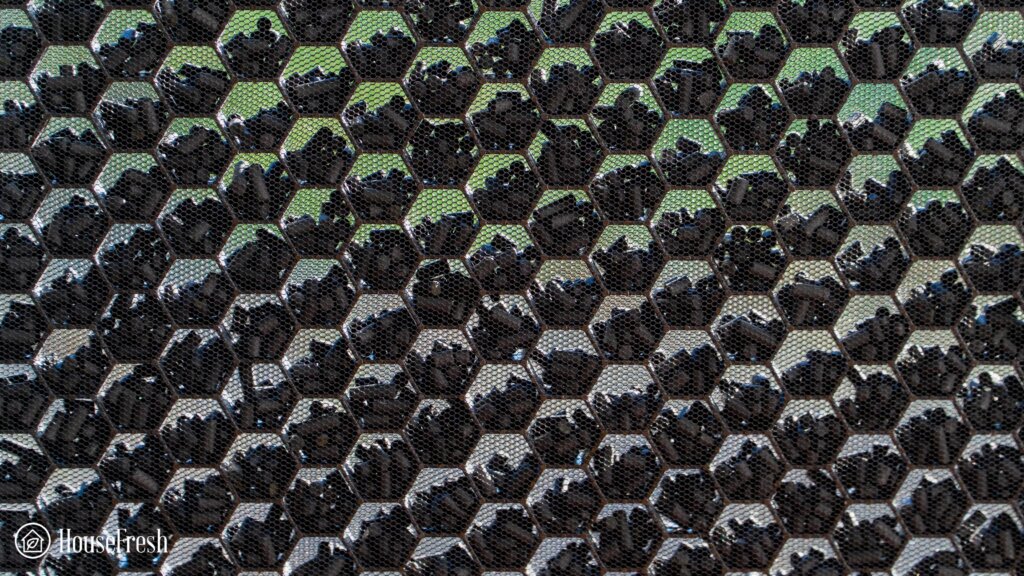
| HouseFresh rating: | ★★★★★ |
| Time to clean our 728 cubic feet test room (with the device running at top speed): | 23 minutes (with PlasmaWave) |
| Air purifier technology: | PlasmaWave, removable pre-filter, washable activated carbon filter and True HEPA filter |
| Recommended room size (4.8 air changes per hour): | 360 sq. ft. |
| Clean air delivery rate (CADR): | Dust: 243 CFM Smoke: 232 CFM Pollen: 246 CFM |
| Dimensions (in inches / cm): | 15W x 8.2D x 23.6H inches (38W x 21D x 60H cm) |
| Weight (in pounds / in kg): | 14.8 lbs (6.7kg) |
| Filter life: | 12 months |
| Noise level in decibels (measured from 3 ft. away with a sound level meter): | Speed 1: 38.8 dB Speed 2: 42.5 dB Speed 3: 47.5 dB Speed 4: 58.9 dB |
| Electricity consumption in watts (recorded with an electricity usage monitor): | Standby mode: 0.34 watts Speed 1: 6.5 watts Speed 2: 9.11 watts Speed 3: 14.80 watts Speed 4: 53.46 watts |
| Estimated running cost (electricity consumption + official filter replacement): | $161.53 per year |
| Cost per CADR cfm (based on dust CFM as reported by AHAM): | $0.66 |
| Manufacturer’s warranty: | 2 year |
| Country of manufacture: | South Korea |
4. Best smart option: Levoit Core 400S (with 0.99 lbs carbon)
If you pair the Core 400S with Levoit’s Smoke Remover filter, you will get 450 grams (0.99 lbs) of pelleted activated carbon.

The Levoit Core 400S is a medium-sized air purifier that can move a lot of air through its cylindrical filter quite fast, completing our particle removal test in 24 minutes (or one minute slower than the 5500-2 above). Levoit made a few different filters for the 400S, each with different amounts of carbon inside. For those looking to tackle VOCs in rooms no larger than 319 sq. ft., I recommend going for the Smoke Remover filter, as it comes with 450 grams of carbon. Alternatively, you can go for the Toxin Absorber filter, as it has 400 grams of carbon inside.
But the reason why I included the Core 400S in this list is because I know some of you will be looking for an air purifier you can manage from your smartphone and connect to your smart home setup. The 400S comes with smartphone connectivity through Levoit’s VeSync app, which is, in my opinion, the best app out there across the nearly 100 air purifiers I have tested here at HouseFresh.
What we really like
What we think could be better
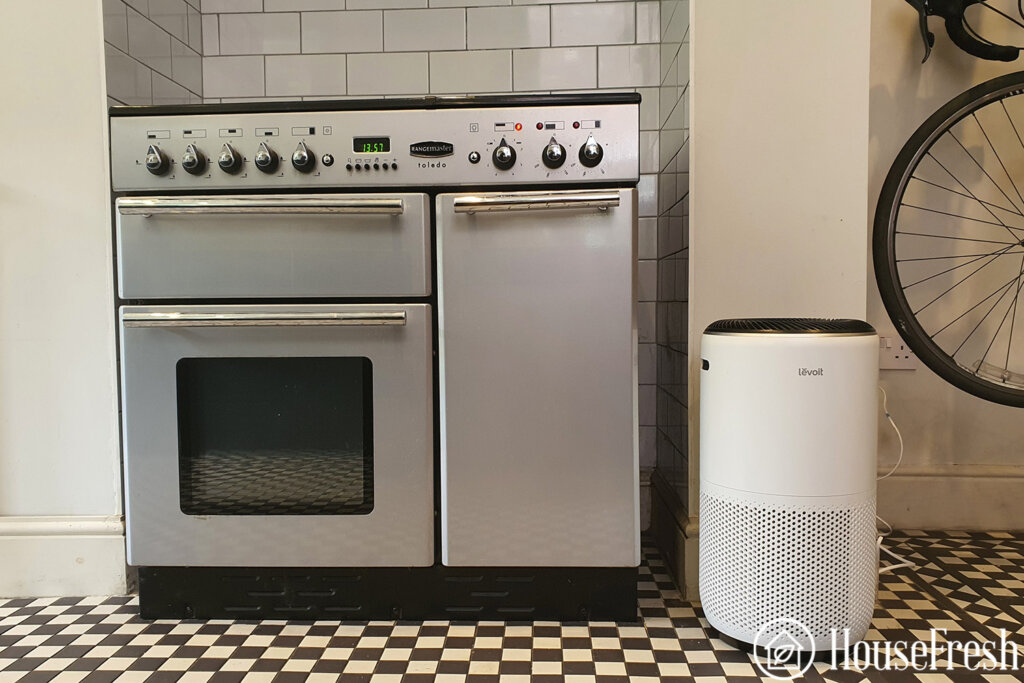
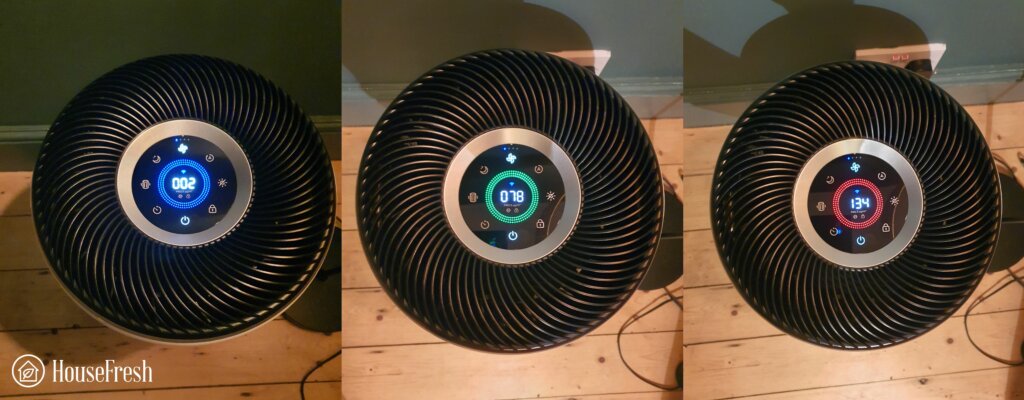
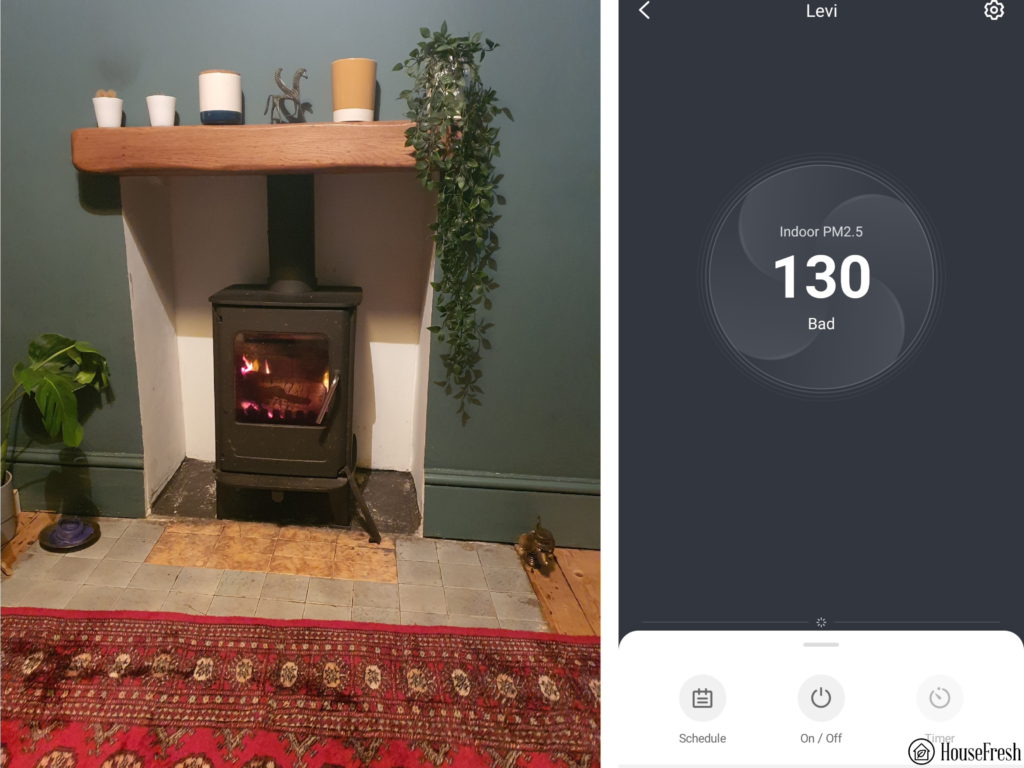
| HouseFresh rating: | ★★★★★ |
| Time to clean our 728 cubic feet test room (with the device running at top speed): | 15 minutes |
| Air purifier technology: | H13 HEPA filter (and optional activated carbon filter) |
| Recommended room size (4.8 air changes per hour): | 703 sq. ft. |
| Clean air delivery rate (estimated CADR): | 435 CFM |
| Dimensions (in inches / in cm): | 22.6L x 13W x 24.8H inches (57.5L × 33W × 63H cm) |
| Weight (in pounds / in kg): | 59 lbs (26.8 kg) |
| Filter life: | 13 months |
| Noise level in decibels (measured from 3 ft. away with a sound level meter): | Speed 1: 44.9 dB Speed 2: 51.2 dB Speed 3: 56.3 dB |
| Electricity consumption in watts (recorded with an electricity usage monitor): | Standby mode: 0 watts Speed 1: 51.9 watts Speed 2: 87.4 watts Speed 3: 122.7 watts |
| Estimated running cost (electricity consumption + official filter replacement): | $285.29 per year |
| Cost per CADR cfm (based on dust CFM as reported by AHAM): | $1.38 |
| Manufacturer’s warranty: | 1 year |
| Country of manufacture: | China |
5. Best for large spaces: Smart Air Blast Mini (1.56 lbs carbon)
A good choice for those looking for an air purifier for a room of up to 600 sq. ft. BUT make sure to also buy the optional activated carbon filter to tackle VOCs and unwanted odors.
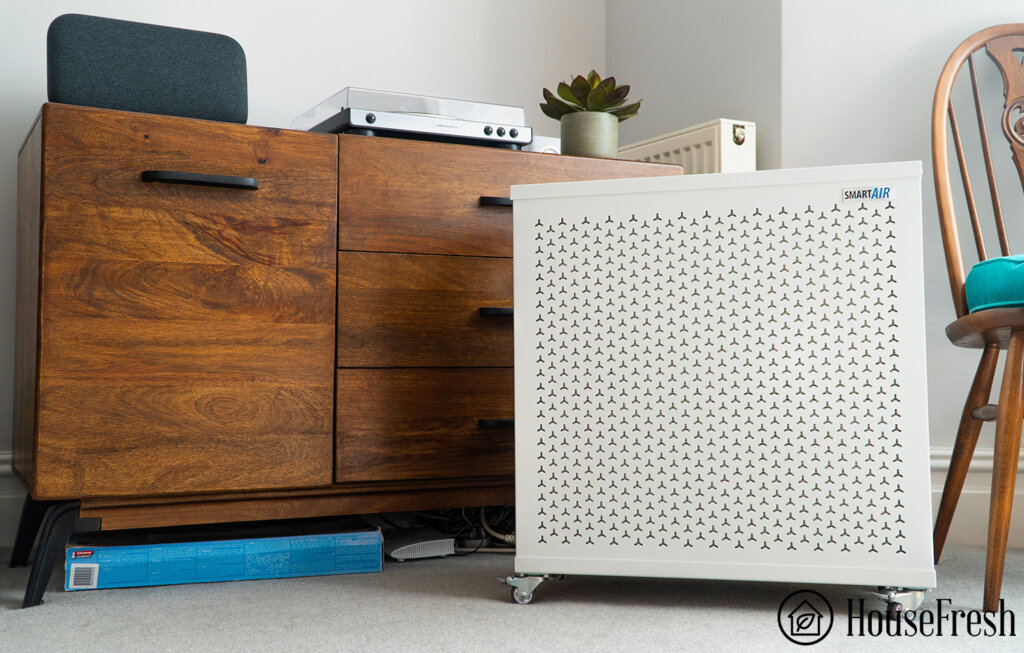
The Blast Mini from Smart Air is a truly powerful air purifier that sits at the top of our leaderboard in terms of its air cleaning performance, completing our particle removal test in just 15 minutes. However, VOCs are not particles, so if you like what the Blast Mini has to offer, then you need to buy the version that comes with 1.5 lbs of pelleted activated carbon.
Similarly to the Austin Air HealthMate above, the Blast Mini’s body is entirely made of metal, and the controls have been simplified to a one-dial operation without any bells or whistles. This is a no-nonsense device with a BIG H13 medical-grade HEPA filter inside and a very powerful fan.
What we really like
What we think could be better
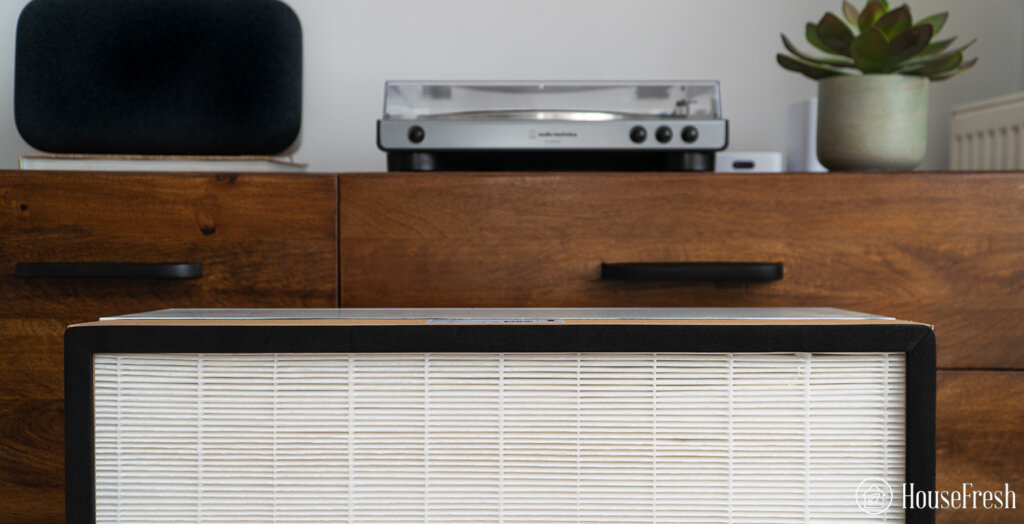
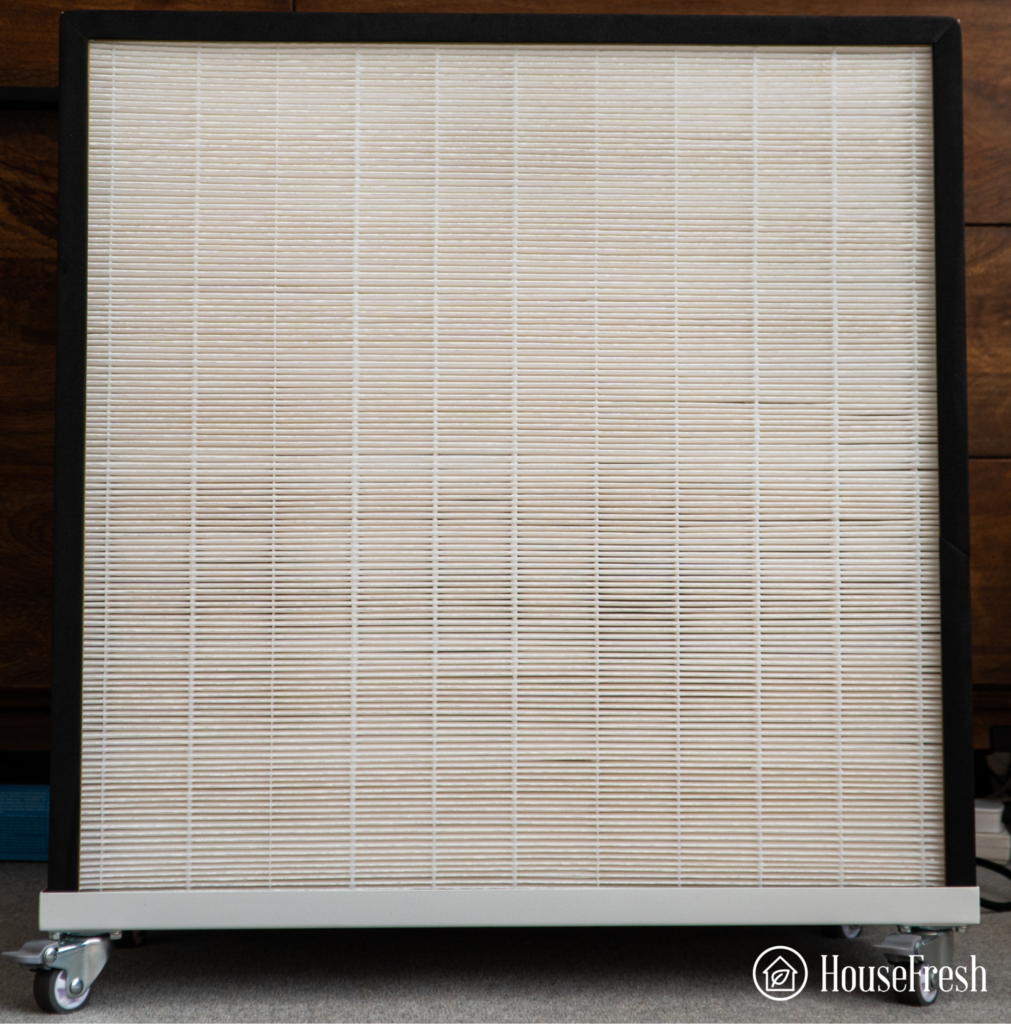

| HouseFresh rating: | ★★★★★ |
| Time to clean our 728 cubic feet test room (with the device running at top speed): | 15 minutes |
| Air purifier technology: | H13 HEPA filter (and optional activated carbon filter) |
| Recommended room size (4.8 air changes per hour): | 703 sq. ft. |
| Clean air delivery rate (estimated CADR): | 435 CFM |
| Dimensions (in inches / in cm): | 22.6L x 13W x 24.8H inches (57.5L × 33W × 63H cm) |
| Weight (in pounds / in kg): | 59 lbs (26.8 kg) |
| Filter life: | 13 months |
| Noise level in decibels (measured from 3 ft. away with a sound level meter): | Speed 1: 44.9 dB Speed 2: 51.2 dB Speed 3: 56.3 dB |
| Electricity consumption in watts (recorded with an electricity usage monitor): | Standby mode: 0 watts Speed 1: 51.9 watts Speed 2: 87.4 watts Speed 3: 122.7 watts |
| Estimated running cost (electricity consumption + official filter replacement): | $285.29 per year |
| Cost per CADR cfm (based on dust CFM as reported by AHAM): | $1.38 |
| Manufacturer’s warranty: | 1 year |
| Country of manufacture: | China |
Other good air purifiers for VOCs that didn’t make the cut
These devices didn’t make the shortlist but are worth mentioning due to their good performance and solid carbon filters.
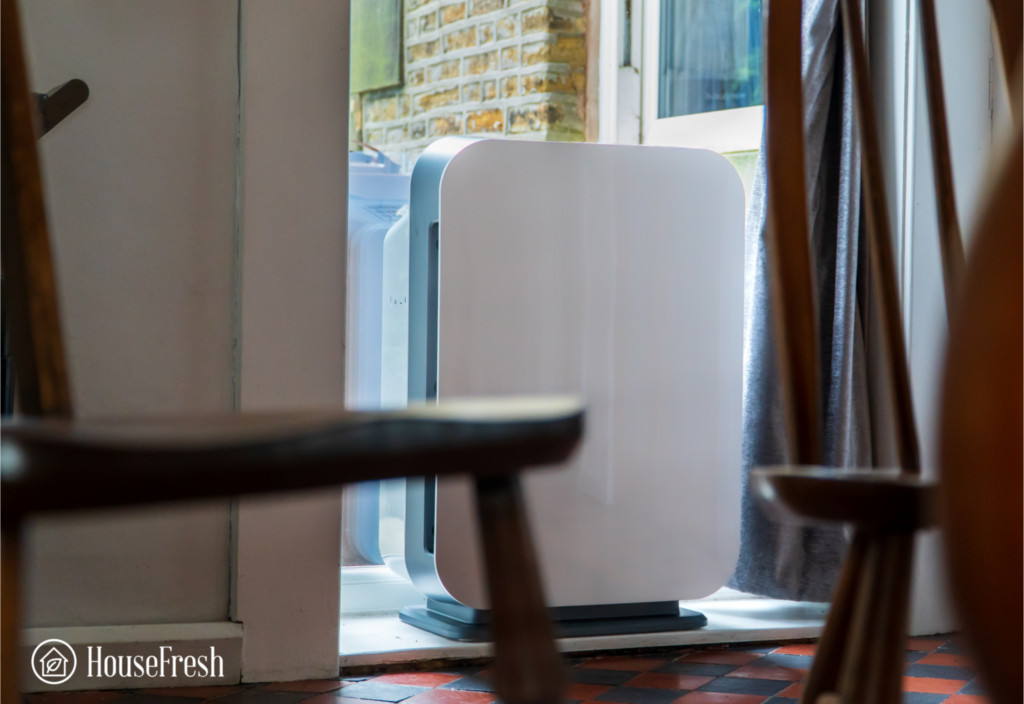
Alen BreatheSmart 75i
Alen has been manufacturing air purifiers since 2005, and the Alen BreatheSmart 75i is their flagship model.
When buying a 75i, you will be prompted to choose a filter from three options designed to tackle different air quality issues. For VOCs, you have to go for Alen’s B7-Fresh True HEPA Filter, which comes with a True HEPA filter plus a good amount of activated carbon.
As with most of the air purifiers on this list for VOCs, the Alen BreatheSmart 75i doesn’t come cheap at $750. It didn’t make the list because we have two other similarly priced units at the top of the shortlist that offer a better warranty for this high price. However, you can get a lifetime warranty for your 75i as long as you set up a filter replacement subscription directly with Alen.
Read our full review of the 75i to find out more about this device.
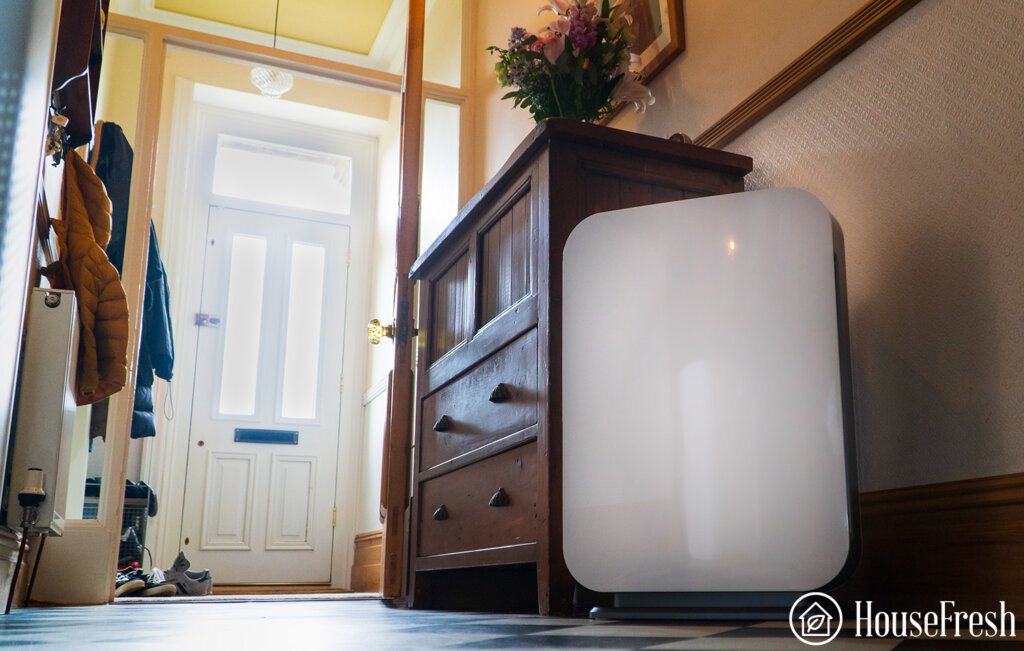

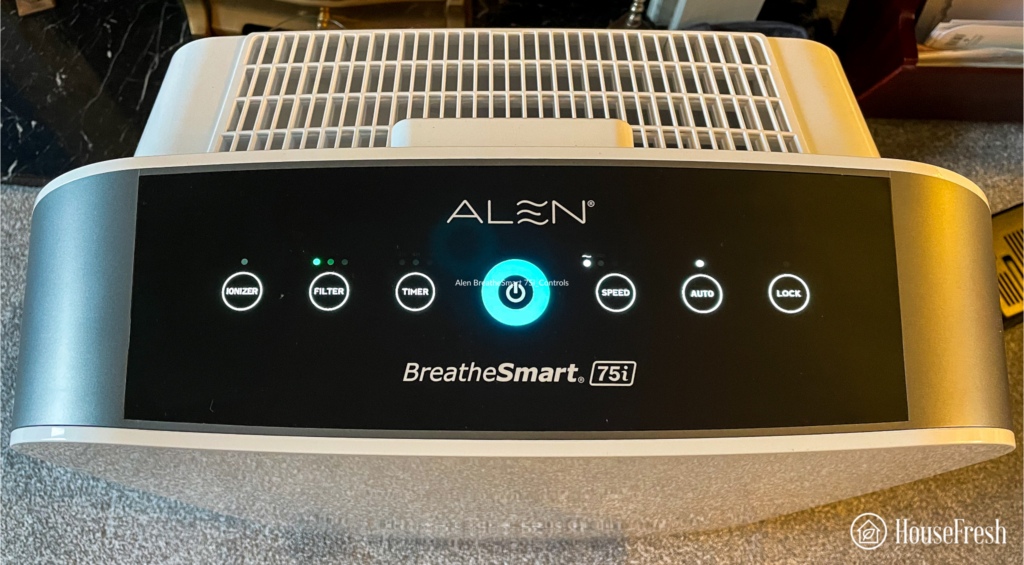
If you like the look of the 75i but feel it will be too big and bulky for your mid-sized room, then look no further than the Alen 45i.

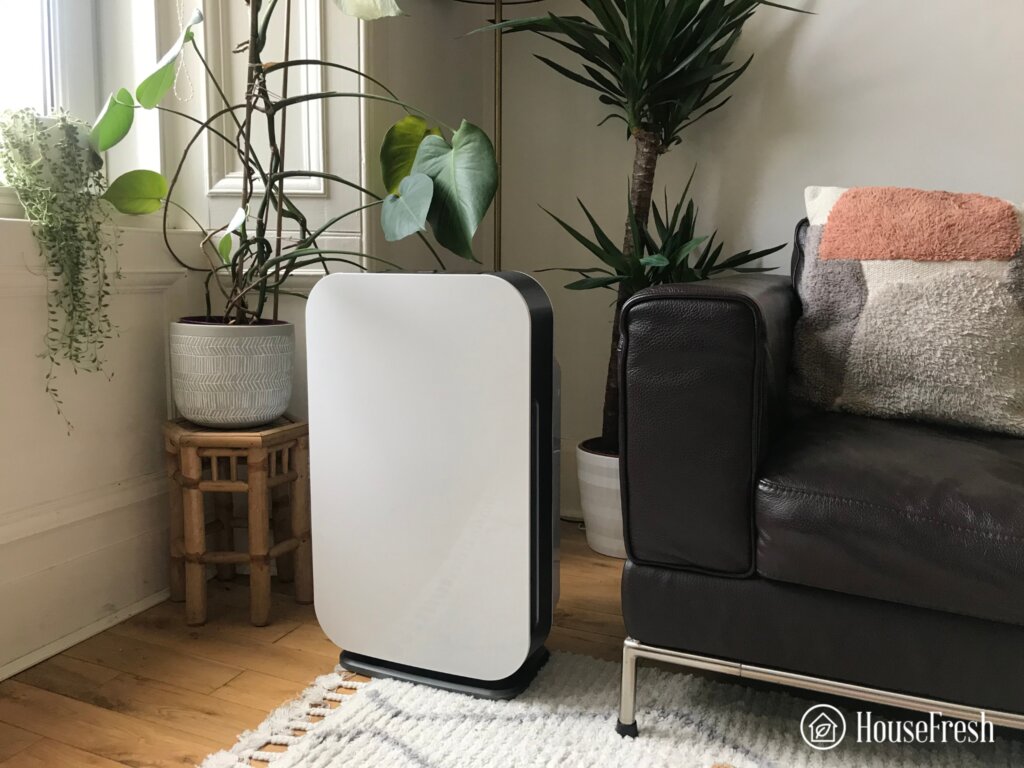

The highest amount of activated carbon is inside the VOC/Smoke filter, which costs an extra $50 but will be well worth it for those needing to tackle VOCs and odors in spaces no larger than 297 sq. ft. Make sure to read our full review of the Alen 45i to find out more about it.
What to look for when buying an air purifier for VOCs
From irritating your eyes and throat to damaging your organs and nervous system, the dangers of VOCs can be severe and must be addressed. Your best option is to pick an air purifier specifically designed to absorb these chemicals. But not all air purifiers are made equal…
1. Choose an air purifier with a large amount of activated carbon
Activated carbon is simply carbon that has been oxidized to create millions of ultra-wide pores that can absorb gas molecules effectively. You can mainly remove VOCs with the help of powerful activated carbon filters, as these will trap gasses and vapors in addition to smells associated to smoke, pets and cooking.
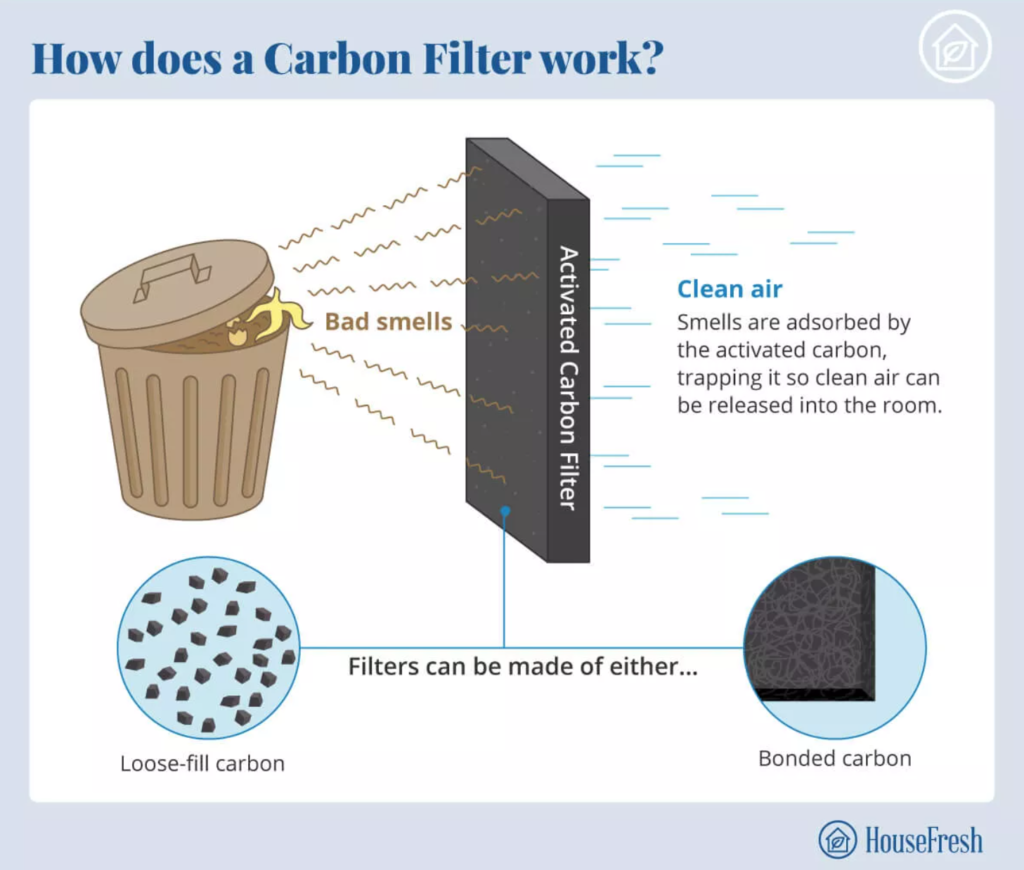
The downside to this type of filtration is that the amount of gases an activated carbon filter can deal with is directly connected to the quantity of activated carbon in the filter itself. That is why you should aim for an air purifier with as much activated carbon as possible.
2. Ensure the air purifier will be powerful enough to clean a space as big as your room
Even though it might feel like a drag, take the time to measure the space where you will be placing your air purifier to ensure that the space is not too big for the air purifier to clean.
The best way to know whether a unit will do a good job in the room you intend to use it in is to use our calculator to see what CADR rating you should look for:
3. Consider noise levels if you’re sensitive to sound
Since your device will likely run at full speed 24/7 while dealing with VOCs in the air, you must consider the associated noise level before purchasing it.
If you can, buy the biggest, most powerful air purifier you can live with. Run it at lower fan speeds, where it will generate less noise while still effectively cleaning the air.
There are quiet air purifiers, but sadly most of them don’t use a large amount of activated charcoal, so they are not a good fit for removing VOCs.
4. Keep upfront costs in mind but also calculate replacement filter costs
These air purifiers are costly, especially the ones that use large amounts of activated carbon. And the thing with carbon filters is that they will become full eventually and you will need to replace them (except for the Winix 5500-2, where you can just wash, dry and reuse the carbon).
As a rule of thumb, always check the price of the air purifier itself and the price of the replacement filter(s). That way you will be able to calculate how much you will need to spend each year to run the device in your home. Air purifier manufacturers include filter lifespan figures on their websites, and we also include this information it the tables with specifications you will find throughout this page.
Wrapping up
Air purifiers aren’t difficult to find, but when you want them to handle volatile organic compounds (VOCs), you must pay extra attention to what type of filters the device comes with.
HEPA filters are popular but unable to clear odors and chemicals from the air, so you want to choose an air purifier with a gas filter that comes with a large amount of activated carbon.
If you can afford it, then our top choice is the IQAir HealthPro Plus, hands down.




